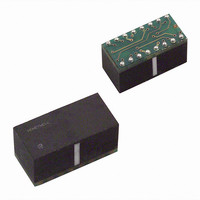HMC1023 Honeywell Microelectronics & Precision Sensors, HMC1023 Datasheet - Page 5

HMC1023
Manufacturer Part Number
HMC1023
Description
SENSOR LINEAR MAGN 3 AXIS 16-BGA
Manufacturer
Honeywell Microelectronics & Precision Sensors
Type
Linearr
Datasheet
1.HMC1023.pdf
(7 pages)
Specifications of HMC1023
Rohs Status
RoHS non-compliant
Sensing Range
±6g
Voltage - Supply
5 V ~ 25 V
Output Type
Differential Voltage
Features
Compass - Three Axis
Operating Temperature
-40°C ~ 125°C
Package / Case
16-BGA
Current - Supply
-
Current - Output (max)
-
Other names
342-1006
Available stocks
Company
Part Number
Manufacturer
Quantity
Price
Company:
Part Number:
HMC1023
Manufacturer:
ANAREN
Quantity:
5 000
Company:
Part Number:
HMC1023LP5E
Manufacturer:
HITTITE
Quantity:
1 400
Company:
Part Number:
HMC1023LP5ETR
Manufacturer:
HITTITE
Quantity:
12 800
HMC1023
SENSOR PRODUCTS
Basic Device Operation
The Honeywell HMC1023 magneto-resistive sensor is composed of three Wheatstone bridge elements to measure
magnetic fields for both field strength and direction. With power applied to the bridges, the sensors elements convert
any incident magnetic field in each element’s sensitive axis direction to a differential voltage output. In addition to the
bridge elements, these sensors have two types of on-chip magnetically coupled straps; the offset straps and the
set/reset strap. These straps are Honeywell patented features for incident field adjustment and magnetic domain
alignment; and eliminate the need for external coils positioned around the sensors.
The magnetoresistive sensors are made of a nickel-iron (Permalloy) thin-film deposited on a silicon wafer and
patterned as a resistive strip element. In the presence of a magnetic field, a change in the bridge resistive elements
causes a corresponding change in voltage across the bridge outputs.
These resistive elements are aligned together to have a common sensitive axis (indicated by arrows on the pinouts)
that will provide positive voltage change with magnetic fields increasing in the sensitive direction. Because the output
only is in proportion to the one-dimensional axis (the principle of anisotropy) and its magnitude, additional sensor
bridges placed at orthogonal directions permit accurate measurement of arbitrary field direction. The combination of
sensor bridges in this three orthogonal axis configuration permit applications such as compassing and magnetometry.
The individual sensor offset straps allow for several modes of operation when a direct current is driven through it.
These modes are: 1) Subtraction (bucking) of an unwanted external magnetic field, 2) null-ing of the bridge offset
voltage, 3) Closed loop field cancellation, and 4) Auto-calibration of bridge gain.
The set/reset strap can be pulsed with high currents for the following benefits: 1) Enable the sensor to perform high
sensitivity measurements, 2) Flip the polarity of the bridge output voltage, and 3) Periodically used to improve
linearity, lower cross-axis effects, and temperature effects.
Noise Characteristics
The noise density for the HMR1023 series is around 50nV/sqrt Hz at the 1 Hz corner, and drops below 10nV/sqrt Hz
at 20Hz and begins to fit the Johnson Noise value at around 5nV/sqrt Hz beyond 100Hz. The 10Hz noise voltage
averages around 0.58 micro-volts with a 0.16 micro-volts standard deviation. These values are provided with a 5-volt
supply.
Offset Strap
The offset strap is a spiral of metalization that couples in the sensor element’s sensitive axis. In the HMC1023 design,
there is one strap per bridge with both ends brought out externally. Each offset strap measures nominally 50 ohms,
and requires about 4.6mA for each gauss of induced field. The straps will easily handle currents to buck or boost
fields through the ±6 gauss linear measurement range, but designers should note the extreme thermal heating on the
sensor die when doing so.
With most applications, the offset strap is not utilized and can be ignored. Designers can leave one or both strap
connections (Off- and Off+) open circuited, or ground one connection node. Do not tie positive and negative strap
connections together of the same strap to avoid shorted turn magnetic circuits.
Set/Reset Strap
The set/reset strap is another spiral of metalization that couples to the sensor elements easy axis (perpendicular to
the sensitive axis on the sensor die). The HMC1023 set/reset strap circuit has three straps (one per sensor) paralleled
together for operation at low voltages. The set/reset strap connections have a nominal resistance of 3.0 ohms with a
minimum required peak current of 1.5A for reset or set pulses. With rare exception, the set/reset strap must be used
to periodically condition the magnetic domains of the magneto-resistive elements for best and reliable performance.
A set pulse is defined as a positive pulse current entering the S/R+ strap connection. The successful result would be
the magnetic domains aligned in a forward easy-axis direction so that the sensor bridge’s polarity is a positive slope
with positive fields on the sensitive axis result in positive voltages across the bridge output connections.
Solid State Electronics Center • www.magneticsensors.com • (800) 323-8295 • Page 5


















